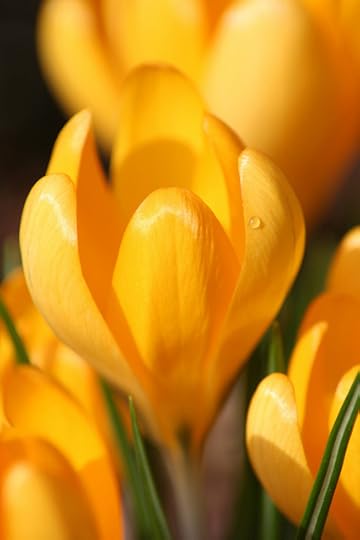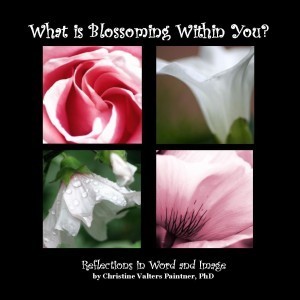Christine Valters Paintner's Blog, page 150
May 1, 2014
Monk in the World guest post: Melinda Thomas Hansen
I am delighted to share another beautiful submission for the Monk in the World guest post series from the community. Read on for Melinda Thomas Hansen's wisdom about the dance of becoming a monk in the world:
It is all too easy to fill my hours with tasks – things that need doing. There are classes to plan, lectures to prepare, websites to build; bills to pay, emails to answer, and products – necessary and unnecessary – to search for on Amazon. The tasks have a way of making themselves seem to be of utmost importance. They arrange themselves in lists on notepads and in my calendar. They fill up space the way hours fill up days.
While it is true that many of the tasks are necessary to sustain my business and lifestyle, most are not vital. That is to say they are not essential to the animating energy of being alive. (My yoga students might disagree when it comes to class plans.)
Living as a monk in the world is, for me, about vitality. It is to make conscious time and space for those activities and states of being that nourish my own alive-ness. And, at the same time, infusing the tasks of living with as much vitality as possible. To balance tasks with activity, doing with being, is the integrative path of the monk in the world. I don’t deny the lists of things that need doing as important, but I do my best to keep them in proper perspective.
And so, the day becomes a dance. A series of staccato steps that move through the lists, checking items off, bringing the same lightness and satisfaction that comes from engaging in cardiovascular activity. The body and mind has been exercised. Sweat drips from the pores like tasks falling away from the list.
The dance slows, grows lyrical. Breath moves deeper as attention descends from the frenetic head to the deep pulse of heart. There are trees to visit. Skys to admire. What could be more vital than fresh air brushing against bare skin, filling lungs, clearing vision?
I move through the day in rhythms. From the quiet moments of awakening, through the routines of breathing, eating, and bathing. Then the tasks begin. Sometimes they last for hours. Sometimes all day if I let them. The trick is to find the moments of pause, the lyrical spaces in-between and to decide. To decide to let the dance slow. To switch partners and allow Grace to lead rather than the tasks. To choose to give time and space to those activities that nourish my own vitality: writing, walking, meditation, asana, study; listening to inspiring music while cooking dinner or enjoying the sound of oils crackling in the frying pan. These are the activities that nourish my inner monk.
Allowing the tasks to lead the dance of the day for too long brings a superficial satisfaction that easily gives way to disconnect, listlessness and the nagging sense that my life lacks meaning. Making conscious choices to carve minutes or hours out of my day devoted to dancing with Grace, to being creative or contemplative, quiet in silence or joyful in song, infuse purpose and direction back into my life.
And yet, there’s danger here too. Too much creative or contemplative time, too much quiet and stillness and I begin to to neglect the world in which I inhabit. The dishes pile up, emails go unanswered, and it’s eggs for dinner again.
The trick seems to be not so much in the number of hours I afford to tasks or vital activities, but in the amount of presence I bring to each one. When I offer my full attention to whatever I am engaged in at the moment, when I invite the broad expanse of the sky to embrace the focused light of awareness I get a glimpse of integration. I get a sense that everything has a season. Even the tasks. And that each season has it’s own beauties, it’s own Graces. To be aware of the Grace leading each season, each task, each step in the dance is to be fulfilled.
Now, as I await the the birth of my first child (somedays with greater patience than others), I begin to open new parts of myself to this dance. In particular, to recognize that the difference between a monk and a hermit is community. Too often I live as a hermit in the world, stepping out occasionally into relationship when convenient or necessary. Now, my dance is widening, opening more fully to others, inviting people into my daily rhythms with greater compassion and generosity of spirit. This part of the dance is not so choreographed. I stumble a lot. I still trip and fall over the dance of tasks and vitality, but I trip and fall over the steps that welcome others into my world even more. But I want to be in community. I want to enjoy this part of the dance. So I buy birthday cards in advance – and then remember to mail them. I make a point of sending messages or better yet calling (really working on this one) to check in on friends. I practice listening to what others have to say with less regard for what I might say in response. It’s not easy. I often feel awkward. But if I can soften and let Grace take the lead in tasks, in vitality and in community, then I can truly live, if only for a moment, as grace-filled, monk dancing in the world.
 Melinda Thomas Hansen practices living as a monk in the world through writing, art, teaching yoga, and engaging in relationship. Melinda blends ancient wisdom with modern understanding to guide others from feeling stuck, disconnected or uninspired to a vibrant, creative and nourishing daily experience of Life. Visit her at www.thehouseholderspath.com.
Melinda Thomas Hansen practices living as a monk in the world through writing, art, teaching yoga, and engaging in relationship. Melinda blends ancient wisdom with modern understanding to guide others from feeling stuck, disconnected or uninspired to a vibrant, creative and nourishing daily experience of Life. Visit her at www.thehouseholderspath.com.
Click here to read all the guest posts in the Monk in the World series>>
April 28, 2014
Practicing Resurrection (a love note from your online Abbess)
Dearest monks, artists, and pilgrims,
I am still traveling and teaching, so this week I offer you a reprise of another article I wrote for Patheos last year on Practicing Resurrection this Easter season:
Lent is a powerful season of transformation. Forty days in the desert, stripped of our comforts, and buoyed by our commitment to daily practice so that we might arrive at the celebration of Easter deepened and renewed.
But often, we arrive at the glorious season of resurrection and celebrate for that one day, forgetting it is a span of 50 days, even longer than the Lenten season through which we just traveled. Easter is not just the day when the tomb was discovered empty, but a span of time when days grow longer in the northern hemisphere, blossoms burst forth, and we are called to consider how we might practice this resurrection in our daily lives.
The soul's journey through Lent is like a pilgrimage exploring inner desert places, landscapes, thresholds, and the experience of exile. Ultimately, pilgrimage always leads us back home again with renewed vision. Resurrection is about discovering the home within each one of us, remembering that we are called to be at home in the world, even as we experience ourselves exiled again and again.
And perhaps there is no place of greater exile than what many of us experience in relationship to our bodies in this fast-paced consumer culture. We spend money on products to make ourselves more beautiful. We diet and fast and often go to extremes to try to mold ourselves to an external model of bodily "perfection." We seek out quick fixes through a variety of medications. Over and over again, we are sold a thousand ways to be unhappy with our physical beings.
The Gospel readings during the Easter season are about the resurrection appearances of Jesus, and many of them have to do with the life of the body: Thomas doubts and needs to touch Jesus' wounds; the nets are pulled ashore overflowing with fish; the disciples on the road to Emmaus recognize Jesus in the breaking of the bread; Jesus breathes on them the gift of the Spirit; and of course there is the celebration of breath and fire at Pentecost. In all of these stories, there is a sense of generosity and abundance, of caring for physical needs, and of finding solace and assurance in the wounds.
Beyond bunnies, baskets, chocolate, and jelly beans, Easter calls us to the profound practice of resurrection of the body. Lent calls us to the simplicity of ascetic practices like fasting with holy purpose. Easter calls us to the generous celebration of these bodies, which are such faithful companions.
Resurrection is about entering the fire of our passion and letting it burn brightly. It is about what enlivens us and makes us feel vital—releasing fear and anxiety over what is to come, and embracing this moment here and now. Resurrection calls us to experience the full weight and lightness of our physical being, to claim the beauty of our embodied selves, and to let gratitude for these vessels of aliveness overflow.
Imagine if, during the Easter season, we each took on practices like these:
Make a commitment to move slowly through the world, resisting the demand for speed and productivity that is tearing our bodies apart and wearing them down to exhaustion.
Reject compulsive "busyness" as a badge of pride and see it for what it is—a way of staying asleep to your own deep longings and those of the world around you.
Pause regularly. Breathe deeply. Reject multitasking. Savor one thing in this moment right now. Discover a portal into joy and delight in your body through fragrance, texture, shimmering light, song, or sweetness.
Let yourself experience grief for the vulnerabilities of your body. Be exquisitely tender with yourself and all of the aches and pains and limitations of embodied life. Make a space within to welcome in the sorrow of difficult memories.
Any time you begin to hear the old voices of judgment rise up about your body—whether self-consciousness or criticism or denial—pause and breathe. Then stand firm against those voices, as the desert elders counseled us to do, and tell them you will not offer them sanctuary anymore.
Play some music you love, and dance. Be present to the body's desires in response. Perhaps just a finger tapping at first. Then slowly let the impulse travel up your arm and across your chest, taking root in your heart, so that your dance might emerge from this place. Even just imagining yourself dancing can bring you alive.
Roll around on the grass, the way dogs do with abandon. Release worries about getting muddy or cold or looking foolish. The body isn't concerned with keeping things neat and tidy. Don't hold yourself back.
Every day, at least once, say thank you for the gift of being alive. Every day, at least once, remember the One who crafted you and exclaimed, "That is so very good."
Allow a day to follow the rhythms of your body. Notice when you are tired, and sleep. When you are hungry, eat. When your energy feels stagnant, go for a long walk. In truth, it often takes several days to sink into this kind of attunement, but begin to consider how you might invite this awareness into your daily life.
Be present to the earth-body, which is the matrix of our own being. The earth offers herself so generously for nourishment. Remember that earth-cherishing is intimately connected to cherishing your own embodied being.
What does it mean for us to not just say we believe in a resurrected life, but to truly practice resurrection?
Do you experience the Holy Week to Easter movement from death into life in an embodied way?
Do you breathe in the gift of the Spirit? What will your practices of resurrected life be?
Join us for a new Invitation to Dance on the theme of "Arise and bloom" and another new and fabulous Monk in the World guest post by fellow monk in the world and storyteller Jim Cyr.
With great and growing love,
Christine
Photo by Christine
April 27, 2014
Invitation to Dance: Arise and bloom
We continue our theme this month of "Arise and bloom" through the practice of dance (please visit our Community Lectio Divina practice, Invitation to Photography, and Invitation to Poetry which all explored this theme for April).
I invite you into a movement practice. Allow yourself just 5-10 minutes this day to pause and listen and savor what arises.
Begin with a full minute of slow and deep breathing. Let your breath bring your awareness down into your body. When thoughts come up, just let them go and return to your breath. Hold the image of arising and blooming, planting a seed as you prepare to step into the dance. You don't need to think this through or figure it out, just notice what arises. Let dance guide you on the journey, listen for how your body wants to move.
Play the piece of music below ("Comptine d'un autre été" by Yann Tiersen) and let your body move in response, without needing to guide the movements. Listen to how your body wants to move through space in response to your breath. Remember that this is a prayer, an act of deep listening. Pause at any time and rest in stillness again. Sit with waiting for the impulse to move and see what arises.
After the music has finished, sit for another minute in silence, connecting again to your breath. Just notice your energy and any images rising up.
Is there a word, phrase, or image that could express what you encountered in this time? (You can share about your experience, or even just a single word or image in the comments section below or join our Holy Disorder of Dancing Monks Facebook group and post there.)
If you have time, spend another five minutes journaling in a free-writing form, just to give some space for what you are discovering.
To extend this practice, sit longer in the silence before and after and feel free to play the song through a second time. Often repetition brings a new depth.
*Note: If this is your first time posting, or includes a link, your comment will need to be moderated before it appears. This is to prevent spam and should be approved within 24 hours.
April 24, 2014
Monk in the World guest post: Jim Cyr
I am delighted to share another beautiful submission for the Monk in the World guest post series from the community. Read on for Jim Cyr's wisdom about the grace of stories:
“My story is important not because it is mine, God knows, but because if I tell it anything like right, the chances are you will recognize that in many ways it is also yours… it is precisely through these stories in all their particularity, as I have long believed and often said, that God makes himself known to each of us more powerfully and personally. If this is true, it means that to lose track of our stories is to be profoundly impoverished not only humanly but also spiritually.” ― Frederick Buechner
“Everything happening, great and small, is a parable whereby God speaks to us, and the art of life is to get the message.” –Malcolm Muggeridge.
Do you know why God created people? Because God loves a good story! For me, being a monk in the world is all about hearing and telling God’s story.
Hearing God’s Story
How do I hear God’s story? Through auditus orantis, prayerful listening: prayerful listening to God through centering prayer, prayerful listening to the Scriptures through lectio divinia, prayerful listening to great teachers of wisdom like Fr. Richard Rohr and John O’Donohue through books and audio, prayerful listening to my clients and their families as I intervene in their crises, prayerful listening to the experiences of my life through my journal writing, and finally, prayerful listening to the folk and sacred stories of many traditions. All of these happenings, great and small, become parables whereby God speaks to me. Sometimes I get the message and sometimes I don’t. But God is always speaking God’s story to me.
When I hear it, God’s story is sometimes hilarious, sometimes joyful, sometimes sad, sometimes heartbreaking, sometimes terrifying, sometimes infuriating, and sometimes perplexing. God’s story is always transforming when I hear it with the ear of my heart.
For some reason, God has wired me with an antenna for hearing his voice through stories, both sacred and secular. I have heard God’s voice through the story of Longinus, the centurion who pierced Jesus’ side with a spear. When the blood and water from Jesus’ side spurted into his eyes, his growing blindness was healed and the darkness of his past life was washed away. Longinus went on to be martyred for Christ for refusing to bow down to a Roman idol.
I have heard God’s voice through the story of St. Godric, who for years struggled between the pull of worldly passions and the call of God on his life. Godric finally decided to follow the call of God and became a hermit on the hunting preserves of Sir Flambard, a powerful knight. There Godric became a shepherd to God’s wild creatures and God’s hurting people.
I have heard the voice of God through the story of St. Kentigern, or St. Mungo (“My Darling”) as he was nicknamed. Mungo is the patron saint of Glasgow, Scotland. He was the illegitimate son of a princess of the Scottish lowlands. When it was discovered that the princess was pregnant and she refused to reveal the father, she was rolled down a steep hill and survived only to be set adrift in the ocean in a coracle. Unborn Mungo and his mother were rescued by a hermit who raised Mungo as his foster son. Mungo went on to be a champion of those who were falsely accused and persecuted. Through these stories God has taught me that God can use me even though the first half of my life was broken by abuse, sin, and failure.
Telling God’s Story
How do I tell God’s story? First I attempt, though most times poorly, to incarnate God’s story through listening presence. My work in a jail, a prison, a residential facility, and now as a crisis intervention specialist has allowed me many opportunities to be an ear of God “listening people back into existence.” Listening with compassion is the best way I’ve found to tell God’s story by incarnating it. Putting flesh and blood on the story of God allows people experience God’s love in real time as they struggle with making sense of their own story.
I also attempt to tell God’s story by literally telling it. As a storyteller I tell God’s story from the Hebrew and Christian scriptures. Biblical storytelling has been a way for me to enable people to hear God’s story again as if for the first time as the story becomes incarnate through the teller. Since all truth is God’s truth, and since the truth of God is too big to be contained only in one tradition, I also tell God’s story as it is found in the sacred stories of other traditions and in folktales of different cultures.
I close with a brief story from Iceland of hearing God’s story, telling God’s story, and the power of compassionate listening to incarnate the story of God.
 Jim Cyr is a crisis intervention specialist for the NJ Division of Children and Families’ Children’s Mobile Response and Stabilization Services through Catholic Charities, Diocese of Metuchen. Jim’s storytelling, called “Heart Tales,” seeks to energize people for whole-hearted living through stories of healing, wisdom and faith. Find Jim at www.hearttales.net.
Jim Cyr is a crisis intervention specialist for the NJ Division of Children and Families’ Children’s Mobile Response and Stabilization Services through Catholic Charities, Diocese of Metuchen. Jim’s storytelling, called “Heart Tales,” seeks to energize people for whole-hearted living through stories of healing, wisdom and faith. Find Jim at www.hearttales.net.
Click here to read all the guest posts in the Monk in the World series>>
April 20, 2014
Easter Blessings! (a love note from your online Abbess)
Dearest monks, artists, and pilgrims,
Joyous blessings on this celebration of Easter and the season of resurrection stretching out before us!
I am in the midst of some travels in the U.S. for about a month which began with a lovely visit to my sister-in-law in South Carolina, and now I am heading to Santa Fe to meet up with a dear friend for a couple of days before the Spiritual Directors International conference begins. Then it will be on to Tulsa, OK for the Awakening the Creative Spirit intensive and Lafayette, LA for a private women's group.
If you didn't receive the free gift, What is Blossoming Within You? from last week – here it is! This is a reflective art journal I published a few years ago in print form, but am now sharing digitally as my gift to you, dear monks.
Since I am traveling, I offer you a slightly edited reprise of an article I wrote on springtime a couple of years ago for Patheos:
Spring and all its flowers now
joyously break their vow of silence.
It is time for
celebration, not for
lying low.
–Hafiz
I believe deeply that the seasons have a great deal of spiritual wisdom to offer us if we make space to listen. They teach us of the cycles and seasons of the earth and of our own lives. We are invited into the movements of blossoming, fullness, letting go, and rest, over and over again. Just like the lunar cycles of the moon's waxing and waning, so too does the body of the earth call us into this healing rhythm. The call of the monk in the world is to tend this rhythm ourselves, as part of the way our souls might flourish.
Spring is a time of balance, renewal, and welcoming new life into the world. As the northern hemisphere enters the season of blossoming we are called to tend the places of our lives that still long for winter's stillness as well as those places ready to burst forth into the world in a profusion of color. It takes time to see and listen. Around us the world is exploding in a celebration of new life, and we may miss much of it in our seriousness to get the important things of life done.
In the southern hemisphere, the world is moving toward harvest and release. But perhaps there is a blossoming still happening deep in the soul?
Lynn Ungar has a wonderful poem titled "Camas Lilies" in which she writes: "And you — what of your rushed and / useful life? Imagine setting it all down — / papers, plans, appointments, everything, / leaving only a note: "Gone to the fields / to be lovely. Be back when I'm through / with blooming." Spring is a time to set aside some of the plans and open ourselves to our own blooming.
There is a playfulness and spontaneity to the season of spring that invites us to join this joyful abandon. As Hafiz writes, spring is a time for singing forth and celebration. We are called to both listen deeply to the blossoming within ourselves as well as to forget ourselves — setting aside all of our seriousness about what we are called to do and simply enter the space of being. In this field of possibility we discover new gifts.
On my daily walks I have seen clusters of crocuses thrusting themselves out from the ground into the brilliant sunlight. The branches of cherry trees begin to hum, then burst forth. Small shoots are ready to press outward, anticipating their explosion into a pink spectacle of petals. And in my presence to this dynamic energy I discover places within me humming and bursting forth. I notice my own deep longings wanting to emerge in vibrant ways.
The fertility of spring speaks of an abundantly creative God who is at the source of the potent life force beating at the heart of the world. Created in God's image, we are called to participate in this generous creativity ourselves. Our own blossoming leads us to share our gifts in service to others.
In the Hebrew scriptures the promise of God's abundance is often conceived of as blossoming in the desert. In that harsh landscape, a flower bursting forth from the dry land is a symbol of divine generosity, fruitfulness, and hope. Hope is a stance of radical openness to the God of newness and possibility. When we hope, we acknowledge that God has an imagination far more expansive than we do.
Practice
Take time this week to meditate with gratitude on a flower, appreciating all of its qualities of beauty, how it simply is what it was created to be. Allow yourself to fill with joyful gratitude for the gifts of the earth. Open yourself to experience the fullness of this flower and all of the ways God delights in the beauty of blossoms.
Then shift your focus from the flower to yourself. Take this sense of wonder and awe at the beauty of the flower and imagine how God gazes with delight on the beauty of who you are. What aspects of your being can you imagine God relishing? What are the longings inside of you God is asking you to embrace?
Rest in this awareness of the joy and delight of God in your own beautiful blossoming for several minutes. Notice what new longings it stirs in you.
Join us for a new Invitation to Poetry on the theme of "Arise and bloom", another new and fabulous Monk in the World guest post by fellow monk in the world Cyndi Gallo Callan, and an update from another one of our amazing Earth Monastery Project grant recipients creating a community garden for youth affected by incarceration (plus grant applications are currently being accepted).
We also have two new online programs for summer! Join us for our brand new Novena of Resurrection: Earth as Our First Monastery (May 31-June 8 culminating on the feast of Pentecost) and Exile and Coming Home: An Archetypal Journey through Scripture (June 16-July 27). If you register for them both by May 12th, you also get a free self-study retreat as a bonus (click here to see your choices).
With great and growing love,
Christine
Invitation to Poetry: Arise and Bloom
Welcome to Poetry Party #77!
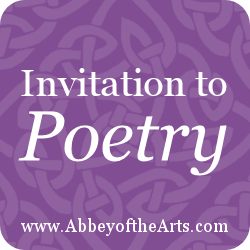 I select an image (the photo above is my own of a peony) and suggest a theme/title and invite you to respond with your own poem. Scroll down and add it in the comments section below or join our Holy Disorder of Dancing Monks Facebook group and post there.
I select an image (the photo above is my own of a peony) and suggest a theme/title and invite you to respond with your own poem. Scroll down and add it in the comments section below or join our Holy Disorder of Dancing Monks Facebook group and post there.
Feel free to take your poem in any direction and then post the image and invitation on your blog (if you have one), Facebook, or Twitter, and encourage others to come join the party! (If you repost the photo, please make sure to include the credit link below it and link back to this post inviting others to join us).
We began this month with a Community Lectio Divina practice with wisdom from the prophet Joel and followed up with our Photo Party on the same theme. (You are most welcome to still participate). We continue this theme in our Poetry Party this month.
The text with which we are praying this month is from the Hebrew wisdom book the Song of Songs, which the ancient rabbis called "the holy of holies." "Arise and bloom" is our theme, tending to the ways our hearts and souls are breaking forth into blossom after a season of fallowness and stillness.
You can post your poem either in the comment section below*or you can join our Holy Disorder of Dancing Monks Facebook group (with more than 1400 members!) and post there.
*Note: If this is your first time posting, or includes a link, your comment will need to be moderated before it appears. This is to prevent spam and should be approved within 24 hours.
April 17, 2014
Monk in the World guest post: Cyndi Gallo Callan
I am delighted to share another beautiful submission for the Monk in the World guest post series from the community. Read on for Cyndi Gallo Callan's wisdom about what matters most:
Prior to Thanksgiving I began thinking about Advent and how I would embrace the season; it always passes so quickly. Instead of how I thought Advent would be embraced, I found myself reflecting on the theme living as a monk in the world, what it meant in my life, and for those around me. The reflections moved through me like tidal currents. It was obvious that the Holy Spirit settled within me, as my mind continually had an overflow of memories and thoughts, but with no clear conclusion as to where to start or how to share it. These reflections came at random times, while in church, at work, or on my yoga mat.
It was 24 years ago, after the birth of my daughter, when I started to grow in my faith. I started to think that if I was intentional and mindful I would eventually get where I was going. So with a lot of life and spiritual growth in-between, I accepted the call to be a Lay Director for a Koinonia weekend retreat in 2011. I was excited and on fire, but when it was over, I felt a letdown instead of the growth I expected. Then a desert came. Needless to say I was devastated. So groping, I had no choice but to reevaluate my faith life, where I was, and where I was going. Obviously I wasn't the one in charge (a spiritual director I had once used to always remind me of that pretty regularly). Am I there yet? Certainly not!
Truthfully, I needed to find contentment with my life; not an easy task for me. Even when life is good, I tend to become overwhelmed very easily. How could I live contently, and embrace contemplative living, when life was a run-on-sentence? As Joan Chittister wrote in her book Illuminated Life, it is very possible to achieve “being contemplative in the midst of chaos.”
First-off, eliminating the unnecessary clutter in my life (both internally as well as externally) was a start, and then embracing the important aspects of life the next step. What was most important was realizing that I couldn't do this alone. God’s grace was there, but I needed to let go, let God.
Refining my life meant an overall overhaul of my mind, body and spirit. Emptying myself and starting from the beginning, was my first step. While for years I claimed to be “health conscious”, I refocused and fine-tuned nutrition, holistic and simple living, consistent exercise which included yoga (which is now a daily practice) and reading books that promoted growth to help balance my mind, body and spirit. Combining this with faith, intention, and mindfulness, I started seeing my interior life of prayer and contemplation, as well as my physical well-being reshape, and reshape some more. Am I there yet? No, not yet.
While there are several areas in my life where I can aspire to living as a monk in the world (or the beginnings of), one area specifically is that of a pro-active mom (and guardian) for my adult son. Jason, 32, is developmentally disabled with cerebral palsy. He was 3 months old when his life tragically was changed. While his cognitive and motor skills are impaired, and the years have not been without their challenges of varying degrees (for both of us), my son has grown into an active, compassionate and social young man.
Almost eleven years ago, six months after his 21st birthday, we decided it would be beneficial to his growth for him to live in a group home. There were also difficulties on the home front during those years and finding a group home which was in his best interest would be a challenge, but by divine intercession, one found us. We visited and immediately knew it was right, but it was almost two hours away. After Easter 2003 he moved. While initially the positives outweighed the negatives, there were challenges to be overcome after the first few years; some serious. In 2010, stress-filled, with new changes forthcoming in my life, I needed to take the “bull by the horn” and be more of an advocate then I had been. With the help of the Holy Spirit, the Advocate, my life started to transform with one of my purposes in life becoming more apparent: my son.
Due to demographics mostly, I did not visit or have Jason home as often as he would like. I would remind him that I didn't see my parents (his grandparents) but once a year (they are 16 hours away), or his brother and sister, who are away at college, as often either. As I continued to empty myself of the unnecessary clutter, there was room for what matters the most.
This past summer I started going down for visits more frequently than in years passed. On Friday evenings the Activities Department where he lives holds either dances or karaoke. Jason loves them both and asked if I would come down and take him to the dances. We agreed on once a month (weather permitting). This time has become important to him (along with other “special” things we do). However, what I also found was that going to these dances not only is a highlight for my son, but it also brightened the lives of the other residents as well.
For me, living as a monk in the world can be realized by living in the present moment, focusing on continued growth of the body-mind-spirit, and being Christ in the world for others in a way consistent with simple living; a content and graceful lifestyle. When we get caught up in the busyness and stuff of the world we can lose our creativity and sense of purpose. In this way I honor not only my life, but also the people I interact with daily, as well as those whose paths I have yet to cross.
 From several east coast “hometowns,” I’ve lived in central Illinois since 1990. I have three adult children. I am the secretary for the Director and Associate Director for Catechesis in my diocese. My interests include cooking, dance, photography, and yoga. I am thankful for my husband who journeys with me. http://cynthiagallocallan.blogspot.ie/
From several east coast “hometowns,” I’ve lived in central Illinois since 1990. I have three adult children. I am the secretary for the Director and Associate Director for Catechesis in my diocese. My interests include cooking, dance, photography, and yoga. I am thankful for my husband who journeys with me. http://cynthiagallocallan.blogspot.ie/
Click here to read all the guest posts in the Monk in the World series>>
April 16, 2014
Earth Monastery Project Update: Youth Chaplaincy Coalition Garden Box Project
Photo: Rev. Dr. Monica Corsaro of Rainier Beach UMC and Rev. Terri Stewart – clearing weeds!
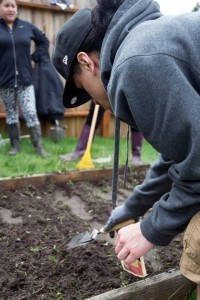 The Earth Monastery Project is a partnership between the Abbey and carefully selected applicants, who will receive resources to complete a Project which nourish an earth-cherishing consciousness and cultivate a vision of the earth as our primary monastery. The EMP is a small grant project funded by donations, income from Amazon Associates program, and through a percentage of fees from Abbey online courses.
The Earth Monastery Project is a partnership between the Abbey and carefully selected applicants, who will receive resources to complete a Project which nourish an earth-cherishing consciousness and cultivate a vision of the earth as our primary monastery. The EMP is a small grant project funded by donations, income from Amazon Associates program, and through a percentage of fees from Abbey online courses.
Rev. Terri Stewart is one of our grant recipients for her project Youth Chaplaincy Coalition: Garden Box Project.
The Abbey Wisdom Council was drawn to Terri's proposal because her project develops a gardening / mentoring program, pairing dedicated mentors with youth affected by incarceration. Not only will the youth have a long-term mentoring relationship, they will have the opportunity for consistent work in the gardening boxes which will also provide food for food-at-risk families.
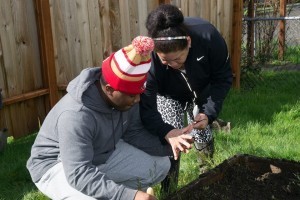 The location of the project is in the South Seattle area, in zip code 98118, the most diverse zip code in the US and the most impoverished zip code in Seattle.
The location of the project is in the South Seattle area, in zip code 98118, the most diverse zip code in the US and the most impoverished zip code in Seattle.
Our grantees from the fall cycle are midway through their projects and so offer their reports which we are excited to share an excerpt from what Terri shared with us.
Photos Right: Above is Fao planting seeds (of hope!) | Below is Sr. Velena Bryant teaching Jonathan how to use his hand to measure the distance to plant seeds.
Youth Chaplaincy Coalition: Garden Box Project by Terri Stewart
In January of 2013, a dream was born to create a ministry that would help youth affected by incarceration by offering mature mentors, gardening, and youth who have been touched by incarceration, gang violence, or substance abuse. We know that mentorship, relationship building, transforms lives—all the social science literature tells us that! What we also know is that a relationship with the earth through gardening prevents recidivism. Social science literature supports that also! We also know one last piece of the pie—nearly every youth in the 98118 zip code has been touched by incarceration, gang violence, or substance abuse. Demographics tells us that. It seemed that targeting Rainier Beach UMC, deep in the heart of the 98118, would be a perfect place to plant a new ministry.
Why is gardening important? It provides concrete bound youth with an opportunity to experience the rhythm of God’s creation and to be exposed to the natural cycle of life rather than the harsh reality of life controlled by timers and bars.
Why is mentoring important? It allows youth to develop a relationship with a mature adult who has walked similar paths of incarceration, violence, or substance abuse and who has risen above and out of their original circumstances.
So we gathered on a cold and wet day, the few brave souls coming to support at-risk youth and earth justice and we planted watermelon, cantaloupe, and corn-on-the-cob. This is just the beginning! The youth will be able to take the items they grow and donate it to food marginalized families or they may choose to eat it! Or, they may choose to sell it—showing them an alternative way of having economic justice.
Earth justice – social justice – food justice – and economic justice. Those are some juicy ministry goals! And they all intersect at RBUMC at the corner of 55th and Roxbury in Seattle.
Applications for our next round of Earth Monastery Project grants are now being accepted through April 3oth! We welcome your proposal! Please see this link for details and feel free to email us with any questions.
Would you consider making a donation to this work and support future projects which nourish an earth-cherishing consciousness? (Go to the bottom of this page for the payment link – credit cards accepted)
April 14, 2014
What is Blossoming Within You? (a love offering from the Abbey)
Dearest monks and pilgrims,
I am getting ready to travel for the next month in the U.S. and there are lots of details to tend to, so this week instead of a love note, I am bringing you a love offering.
Several years ago I self-published a series of small reflective art journals on different themes which included my own photography and art with reflections to ponder. I really loved making them and sending them out into the world.
Every so often, I get an email from someone who has found a copy and wants to order more because they love them so much, but sadly when we moved overseas, we didn't bring them with us. I am so grateful to each and every person who bought one of the physical copies.
I was looking in my archives the other day and realized that it is unlikely I will publish these in physical form again, so for now I am offering What is Blossoming Within You? as a free digital gift and love offering to you! Just download the PDF file and enjoy! Even if it isn't springtime where you live, perhaps there will be a blossoming in your soul sparked by your time of reflection.
These journals were created with much love and the hope that they would invite a time of slowing down and moving inward. They are perfect companions for times of retreat.
Please feel free to share the link to this post with others!
There are other reflective art journals in the series including:
Callings: Becoming Who You Already Are
Crossing the Threshold: New Year, New Beginnings
Illuminating Mystery: Creativity as a Spiritual Practice
and perhaps my favorite one of all - Season by the Sea: A Contemporary Book of Hours
Over the next several months, I will be offering these as free gifts in PDF format for you to savor and guide your reflection. Stay tuned for more love offerings to come. . .
As we enter this Holy Week in the Christian tradition, I send blessings for staying with the difficult things of this world. For me, this week ahead is an invitation to be present to grief and unknowing, as well as the joy and celebration to come.
Join us for a new Invitation to Photography on the theme of "Arise and bloom", another new and fabulous Monk in the World guest post by fellow monk in the world Morgana Morgaine, and an update from one of our Earth Monastery Project grant recipients creating a global dance video (plus grant applications are currently being accepted). We also have a wonderful post from herbalist Tonja Reichley on The Monk's Garden.
We also have two new online programs for summer! Join us for our brand new Novena of Resurrection: Earth as Our First Monastery (May 31-June 8 culminating on the feast of Pentecost) and Exile and Coming Home: An Archetypal Journey through Scripture (June 16-July 27). If you register for them both by May 12th, you also get a free self-study retreat as a bonus (click the links to see the options).
With great and growing love,
Christine
Photo: Cover of What is Blossoming Within You?
Summer Online Programs (and another free gift!)
We have two brand new programs coming in June!
The first is an online Novena of Resurrection – which is a 9-day prayer experience – we are celebrating resurrection and the earth as our first monastery. The retreat will culminate in the feast of Pentecost (and the arrival of the wild Spirit)! A beautiful way to honor the season of Easter or celebrate springtime. Several years ago, when I worked for the Ignatian Spirituality Center, I coordinated the annual Novena experience which was held during Lent. It ended up being one of my favorite parts of the work I did there and I am excited to bring you the power of this prayer form online.
The second is an online course offered previously to just the men of the Abbey community. John Valters Paintner has done some extensive editing and we have added the marvelous voice of Ronna Detrick, and are now making it available to the entire Abbey. (If you participated in the winter version and want to repeat the class for free please email Christine and let her know).
Novena of Resurrection: Earth as Our First Monastery (May 31-Jun 8, 2014)
and
Exile and Coming Home: An Archetypal Journey through Scripture (June 16-July 27, 2014)
Register for both programs by May 12th and receive another free gift - a self-study class from the following options (after making payment for the two programs above, email Christine to let her know which self-study class you would like):
Celtic Spirituality Self-Study Online Retreat
Creative Flourishing: A Self-Study Retreat with the Wisdom of Hildegard of Bingen
Seasons of the Soul
Soul of a Pilgrim
Lectio Divina: The Sacred Art of Reading the World
Eyes of the Heart: Photography as a Contemplative Practice (accompanies Christine's book which is not included)
April 13, 2014
Invitation to Photography: Arise and bloom
Welcome to this month's Abbey Photo Party!
 I select a theme and invite you to respond with images.
I select a theme and invite you to respond with images.
We began this month with a Community Lectio Divina practice with words from the ancient Hebrew text of the Song of Songs. While the northern hemisphere begins to turn to spring through the arrival of birdsong and blossoms, we are all invited to tend to our inner flowering. In my own prayer with the text, the word "arise" shimmered strongly, which is an invitation to awaken from slumber, to take action in the world, to bring more beauty to life.
I invite you for this month's Photo Party to hold these words in your heart as you go out in the world to receive images in response. As you walk be ready to see what is revealed to you as a visual expression of your prayer.
You can share images you already have which illuminate the theme, but I encourage you also to go for a walk with the theme in mind and see what you discover.
You are also welcome to post photos of any other art you create inspired by the theme. See what stirs your imagination!
How to participate:
You can post your photo either in the comment section below* (there is now an option to upload a file with your comment – your file size must be smaller than 1MB – you can resize your image for free here - choose the "small size" option and a maximum width of 500).
You can also join our Holy Disorder of Dancing Monks Facebook group and post there. Feel free to share a few words about the process of receiving this image and how it speaks of the "Arise and bloom" for you.
*Note: If this is your first time posting, or includes a link, your comment will need to be moderated before it appears. This is to prevent spam and should be approved within 24 hours

